The calendar year rolls over to 1982, a year in which the Dots would unleash an onslaught of cassette releases that play in retrospect like a new band practicing to master the art form of the album. While most of this material was still generated in the outburst of manic activity that lead to such unwieldy releases as Kleine Krieg, the band began administering smaller doses of their psychedelic lo-fi electronic madness, and grew all the stronger for it. Premonition, for example, only lasts an hour. Atomic Roses lasts 45 minutes, and Apparition merely 30. All of these early cassettes have been released in digital form, some of them recently remastered, and will be discussed in that order.
But first, a moment about the unstable lineup of the band at this time... Different permutations of what would become the core group of 6 musicians in the band were working on different things at different times, with Edward Ka-Spel having confirmed that at some point there were two competing lineups of the Legendary Pink Dots, of which he was the only common member. So 1982 was reportedly a year in which the band splintered, then awkwardly came back together. This can easily be heard in some of the year's releases. Premonition, for example, is supposedly missing founding members April Iliffe and Phil Knight (aka Phil Harmonix aka The Silver Man). Perhaps that explains its subdued, almost lazy nature.
Premonition
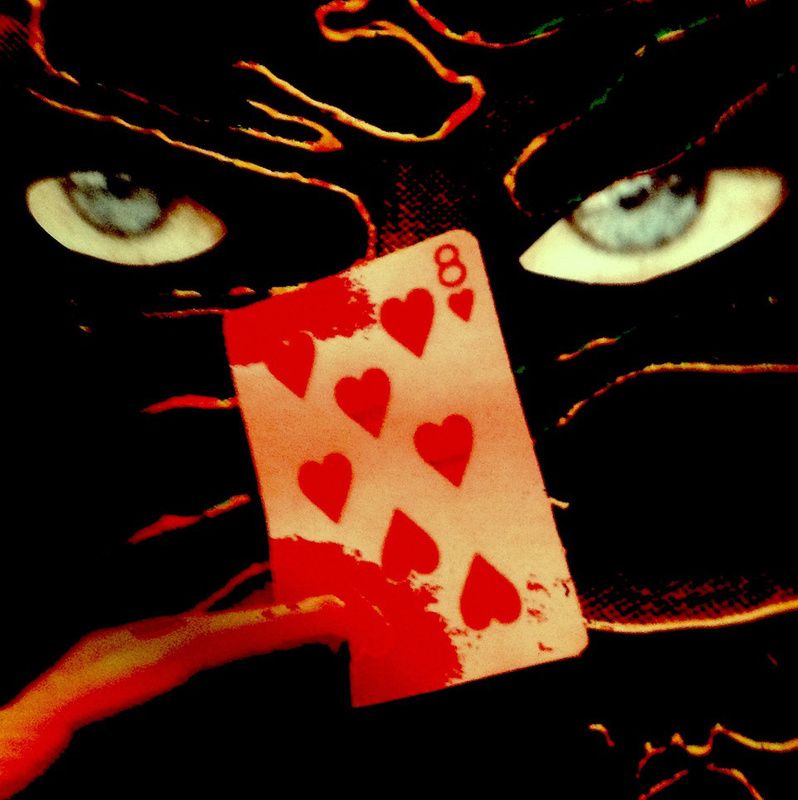
I'll be honest: I don't like this release very much. Premonition is missing a lot of the cohesiveness that makes their next few releases so enjoyable, and it's surely lacking the expansive experimentation that dominates Kleine Krieg. But the cassette remains an important release for a number of reasons, not least of which is the introduction of the "Premonition" concept. As seen here, numbered tracks called "Premonition" would become something of a thing in the Dots' discography, and even though they may not have known so at the time, this series of tracks would eventually become something of a staple for the band. As of 2015, the "Premonition" series numbers in the 40s.
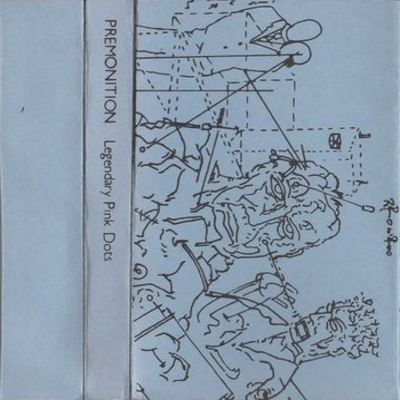
The original Premonition cassette released by Flowmotion in 1982
The album is digitally split into two parts, one each representing a side of the cassette. Part 1 begins with a crescendoing collage piece called "As If...", in which you can hear drones, bleeps, backwards masking, bits of the bridge of "Amphitheatre," and other "Did you hear that?" moments that will recall bits and pieces of other Dots songs. This segues, or rather crossfades, directly into "Splash," a low-key ode to alcoholism that features an uncharacteristically bland vocal by Edward Ka-Spel and adequately sets the tone for the rest of the program with its mushy softness and direct songwriting. It seems clear that this permutation of the band wanted to consolidate its strengths writing three-minute pop bits much like the ones that would dominate their proper debut LP, Brighter Now, before the end of the year. The tendency to crossfade rather than use new interstitial bits to connect the songs together is also slightly less compelling than what the band were doing before.
"Splash" rolls directly into a cool little sequenced bit called "Submerged," which—minus the vocoded speaking—anticipates certain strains of techno years before its popularity took foothold. Next up is a much improved "Amphitheatre," easily the best track here. The melody is simple but catchier, and more audible, than the song demonstrated just a year before, and though it is repetitive, it also boasts notable choruses and an infectious midsection with naïve charm. Another clumsy crossfade leads into a wholly unnecessary encore of "Before the End," a throwback all the way to Only Dreaming and Chemical Playschool Volumes 1 & 2.
Part 1 recovers nicely with the ever-important "Premonition 1." A seven-minute mood track, this one is essentially "City Ghosts" dressed up in white noise and keyboard squeals with some pitch-shifting thrown in for good measure, which raises the question of what the "Premonition" tracks mean. Personally, I have always felt that these tracks are any experimental works that build dreamlike states from samples and pieces of other songs. The track does indeed conjure up an abstract vision of something concrete, but the question remains: Is it a vision of the past, or of the future?
The closer "Premonition 2" is another languid seven-minute track featuring a spoken sample from a political newscast about men standing together and pledged to each other, but it is not clear what cause they are supporting. (I could swear that in its final seconds, the track features bits of "Hauptbahnhof," a song not yet released.) As with the other "Premonition," it is actually a meditative piece unlike anything the Dots have done before. Dream states officially became an important part of the Dots mythos with the "Premonition" recordings, and they would only prove to grow more important as the band's career progressed.
A later version of the Premonition cassette substituted "Before the End" for "Voices" and added an early version of "Love Puppets," which is also included on the Bandcamp version:
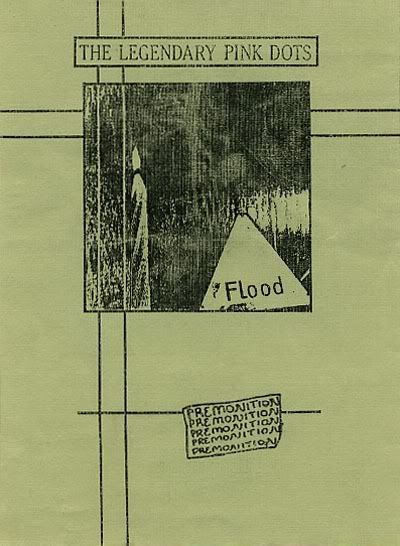
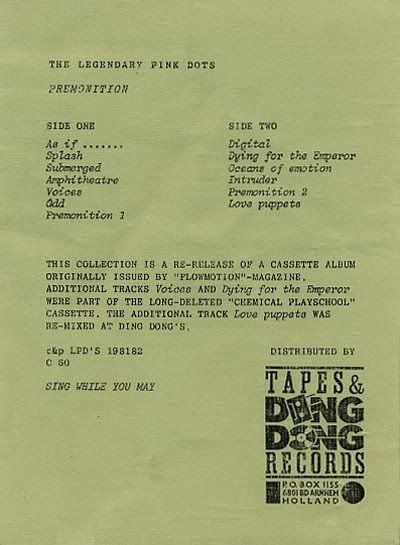
Under Triple Moons

* These tracks appear on the 1982 cassette Premonition
** This track appears on both Only Dreaming and Chemical Playschool Volumes 1 & 2
*** These tracks appear on Kleine Krieg
The five remaining tracks are culled from a 1988 compilation cassette called Traumstadt 2
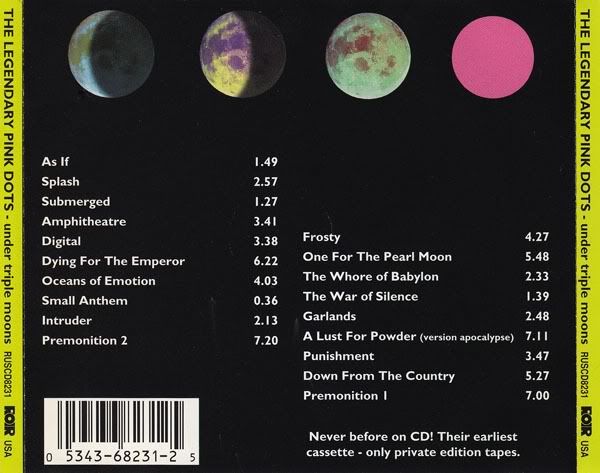
Under Triple Moons back cover (above) and disc (below)
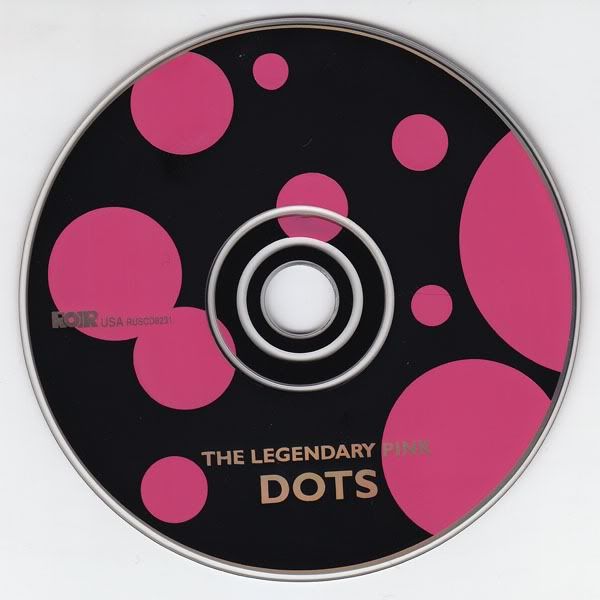
Premonition, as with Only Dreaming's presence on Ancient Daze, was kept more or less intact on a compilation CD released by ROIR in 1997, marking the beginning of a fruitful relationship with ROIR that continued for another decade. The funny thing about this is that the CD was released at a new height in popularity for the band in the '90s, when their legendary tours were drawing large crowds and the albums they were releasing at the time greatly supported this live experience. So the fact that one of the most common CDs to show up in the bins at this time, due to ROIR's presence on American soil and excellent distribution, was billed as "their earliest cassette-only private edition tapes" threw many new fans for a loop.
The additional tracks added to round out Under Triple Moons seem haphazard in their placement. After all, the recording of the tracks range from 1980 to 1984. I can't say much more about "Frosty" than was already described here, but effectively the song is one of the Dots' earliest tracks and it sounds like it. Despite its full arrangement and upbeat sound, the song appears to be about a man so afraid of the world that he is kept preserved in a freezer where no harm will come to him. "One for the Pearl Moon" is next, and it is slightly abridged from its Kleine Krieg form. The next five tracks were recorded 2-3 years later and it shows. The prominence of strings (!!) which we have yet to hear on any Dots tracks thus far are quite the telltale distinction, and though maestro Patrick Wright (aka Patrick Q. Paganini) would become a major player in the band's sound for the next decade, now is not the time to introduce him. [Perhaps I will discuss these tracks later if I try to piece together the Traumstadt 2 retrospective from 1988, from whence these came.] After that detour, we get "Down from the Country," again edited down from its longer form on Kleine Krieg.
<----- GO BACKWARD to Kleine Krieg

2 comments:
Haven't thought about this release in years, though I liked it a lot. In the last couple of days though I've been going crazy trying to place a sample from the new Girl Talk album that I'm almost positive is from one of these tracks - you can hear it at 3:44 here http://www.youtube.com/watch?v=FtsxfquYHf0#t=3m40s. Sound familiar at all? I'm afraid my copy of UTM is long gone...
No, I don't think that particular keyboard was ever used by the Dots; it also sounds a bit too polished to have been them. It's definitely something from the '80s, though.
Post a Comment